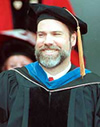2000 Metcalf Award Winners
Dan Clemens
 Students in Professor Dan Clemens’ Stellar and Galactic Astronomy class are required to write a letter each week to a fictitious relative. Aunt Millie never studied astronomy. She cannot tell a red shift from a sundress. But Professor Clemens thinks that a student who can explain mass/luminosity relationships to Aunt Millie is light years closer to understanding them himself.
Students in Professor Dan Clemens’ Stellar and Galactic Astronomy class are required to write a letter each week to a fictitious relative. Aunt Millie never studied astronomy. She cannot tell a red shift from a sundress. But Professor Clemens thinks that a student who can explain mass/luminosity relationships to Aunt Millie is light years closer to understanding them himself.
An astronomer of international standing, Professor Clemens is renowned for his own lucid explications of complicated astrophysical concepts. One student compares his class to “the PBS science series NOVA.” He provides what another student calls a “lasting and valuable lesson” in scientific communication.
But Professor Clemens’ lesson in scientific communication goes far beyond his own dazzling performances. He focuses on his students’ ability to synthesize concepts and present them in good, clear writing and succinct speech. In his Observational Astronomy class, students must combine their knowledge of photometry, spectroscopy, photography, and statistical methods as they work late into the night in the observatory atop the College of Arts and Sciences. But then they must come to class and explain exactly what they did and what they saw.
Astronomers, he warns, can be overwhelmed if they attempt to take in too much of the sky at once. Often, to succeed they must narrow their field of view. But it is an adage Professor Clemens applies only to stars, not to expectations for students. “One of the toughest and most demanding professors I’ve ever met,” writes one student; “a nightmare,” says another, and then praises him to the skies.
Demonstrating a device called a grism, which combines a prism and a gradient, Professor Clemens disperses the spectra of a beam of light onto the classroom wall. The rainbow represents the filaments of information his students might find from distant stars. This is Professor Clemens at work, helping his students isolate and refine their ideas, and holding up the pure light of intelligence as the ideal. For his searching illumination of the minds of his students, we honor Dan Clemens with the Metcalf Award for Excellence in Teaching.
Maureen O’Rourke
 The titles alone are enough to induce drowsiness: the Uniform Commercial Code; Sales and Secured Transactions; the Commercial Law of Intellectual Property. But Professor Maureen O’Rourke, who teaches these very courses to law students, performs a wonder.
The titles alone are enough to induce drowsiness: the Uniform Commercial Code; Sales and Secured Transactions; the Commercial Law of Intellectual Property. But Professor Maureen O’Rourke, who teaches these very courses to law students, performs a wonder.
At the end of her classes, there is not a glazed eye in the room. “Stunning” is how one student describes Professor O’Rourke’s magic on the Uniform Commercial Code. How does she do it? Another student describes her as “dynamic, knowledgeable, rigorously logical, and extremely well organized.” But that can’t explain it.
To turn the dry and intricate into richly textured intellectual inquiry is an art that rivals spinning straw into gold. And students marvel at her achieving such coherence and clarity with such opaque materials.
But as they marvel, they also smile, because part of Professor O’Rourke’s magic is her light touch. She can turn a graceful metaphor like a shortstop hurling a runner out at first; and she brings her own precious baseball signed by Don Mattingly to her Sales and Secured Transactions class, to illustrate value beyond material worth. Deftly ensnaring students in Socratic questioning, Professor O’Rourke teaches them not only the substance of the law but its rationales, its internal logic, and the circumstances in which it gains meaning.
She knows those circumstances because she is also a nationally recognized expert on intellectual property law and the Internet. Her writings on the application of trademark and copyright law to e-commerce are helping to shape the legal foundations of this burgeoning industry. Those legal foundations will be sturdier by the addition of every one of her wide-awake students. For her ability to transform dry law into vibrant learning, we honor Maureen O’Rourke with the Metcalf Award for Excellence in Teaching.
